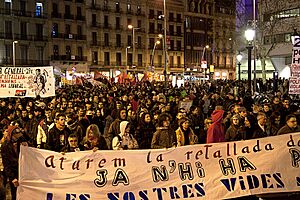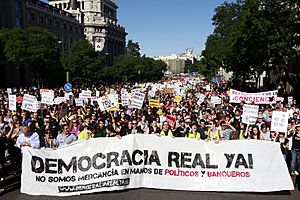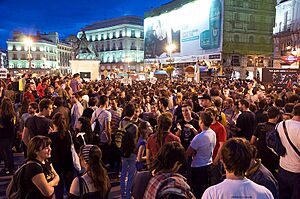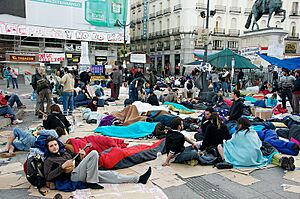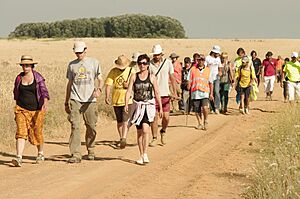Anti-austerity movement in Spain facts for kids
Quick facts for kids 15-M MovementAnti-austerity movement in Spain |
|||
|---|---|---|---|
| Part of the 2008–2014 Spanish financial crisis, the European debt crisis and the impact of the Arab Spring | |||
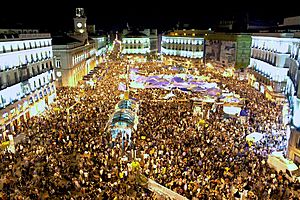
The Puerta del Sol square in Madrid, shown here on 20 May 2011, became a focal point and a symbol during the protests.
|
|||
| Date | 15 May 2011 – 2015 | ||
| Location | |||
| Caused by | Unemployment, economic conditions, welfare cuts, political corruption, particracy, unrepresentative bipartidism, democratic deficit | ||
| Goals | Direct democracy, reduce influence of economic powers in politics, | ||
| Methods | Demonstrations, civil disobedience, civil resistance, rioting, sit-ins, online activism, protest camps occupations | ||
| Number | |||
|
|||
| Injuries and arrests | |||
| Injuries | 1,527+ injuries | ||
The 15-M Movement (also known as the Indignados Movement) was a series of protests in Spain. People were upset about "austerity policies." These policies meant the government cut spending to save money. The protests started around the local and regional elections in 2011 and 2012.
The movement began on May 15, 2011. Many protests spread quickly through social media. Groups like "Real Democracy NOW" (Democracia Real YA) and "Youth Without a Future" (Juventud Sin Futuro) helped organize them.
Spanish news linked the movement to the country's financial crisis. They also saw connections to protests in other places. These included the Arab Spring and demonstrations in Greece and Portugal. The movement was also compared to a book called Time for Outrage!. This book seemed to inspire young people in Spain who were not working or studying.
Protesters were angry about many things. These included high unemployment, cuts to public services, and politicians. They also disliked the two-party system in Spain. This system meant only two main political parties had power. People also protested against banks and corruption. Many demanded basic rights like a home, work, healthcare, and education. The movement brought the idea of protest camps to Europe. This idea later influenced the Occupy Wall Street movement in the USA.
According to RTVE, Spain's public TV, between 6.5 and 8 million Spaniards took part in these events.
Contents
- Why Did People Protest?
- How the Movement Organized Itself
- Key Events in 2011
- Key Events in 2012
- Key Events in 2014
- Key Events in 2015
- See also
- Images for kids
Why Did People Protest?
Spain's Economic Problems
Since 2008, Spain faced a big financial crisis. The country had one of the highest unemployment rates in Europe. It reached a record of 21.3%. By March 2011, nearly 5 million people were unemployed. Youth unemployment was even higher, at 43.5%. This was the highest in the European Union.
In 2010, the government changed labor laws. They wanted to make it easier for companies to hire and fire workers. Big trade unions did not like this plan. They said it would hurt workers. Unions called for a general strike on September 29, 2010. This was the first big strike in ten years.
The government continued with economic changes. In January 2011, they agreed to raise the retirement age. It went from 65 to 67. Some unions disagreed and held strikes. Other protests in Madrid led to clashes with police. Most Spaniards also did not want the retirement age to go up.
New Laws and Early Protests
In February 2011, a new internet law passed. It was called the Sinde law. This law allowed a special group to shut down websites. These sites were shut down if they shared copyrighted content without permission. Many internet users were very critical of this law.
An online campaign called #nolesvotes (don't vote for them) started. It asked citizens not to vote for parties that supported the Sinde law. Before May 15, other protests happened. For example, a student group called "Youth without Future" protested in Madrid. About 5,000 people joined. These early protests were similar to others against education changes. The anti-austerity movement in Portugal also inspired the protests in Spain.
How the Movement Organized Itself
The Role of Social Media
In January 2011, people on social media created "¡Democracia Real YA!" (Real Democracy NOW!). They used Twitter and Facebook to organize. They called on many different groups to protest on May 15. These included unemployed people, those with low pay, and young people.
Protests were planned in many cities across Spain. Some smaller protests also happened in other European cities. These included Dublin, Lisbon, and London. Before the main protests, "¡Democracia Real YA!" held smaller events. For example, they occupied a bank in Murcia.
Key Events in 2011
May 2011: The Start of the Protests
May 15: The First Big Day
The first protest had a motto: "We are not goods in the hands of politicians and bankers." People were angry about banks getting bailouts. They felt the government was cutting social programs instead.
In Madrid, about 50,000 people protested. The police said it was 20,000. The march ended in Puerta del Sol square. Speeches were read there. In Barcelona, 15,000 people protested. Most protests were peaceful. However, in Madrid, some protesters blocked a street. Police used batons to clear them. This led to some damage and arrests. "¡Democracia Real YA!" said they did not support the violence. After the clashes, about 100 people started camping in Puerta del Sol. This led to more protests the next day.
May 16: Camps Begin
More people gathered in Puerta del Sol. They decided to stay until the elections on May 22. In Barcelona, 200 people started a similar camp. Police tried to break it up at first. The hashtag #spanishrevolution became very popular on Twitter.
May 17: Police Action and More Protests
Early on May 17, police cleared the Puerta del Sol camp. Two protesters were arrested. In response, people used SMS, Facebook, and Twitter to call for a big protest at 8 p.m. Thousands returned to the squares. Police allowed camps in some cities. In Madrid, over 12,000 people gathered. Protesters organized into groups for cleaning, communication, and legal help. Local businesses helped by donating food. All arrested protesters were released.
Protests and camps happened in 30 cities. People in the UK also showed support. The camp in Puerta del Sol grew to about 4,000 people. They set up a large canopy and signs. The camp became a symbol of the movement.
May 18: Growing Support and Media Attention
Many protesters wore carnations, like in a revolution in Portugal. Protesters set up a food stand with donated food. They also used a webcam to share news from Puerta del Sol. Police ordered protesters to leave in some cities. Three people were arrested in Granada.
The protests spread to more cities. Protesters created support groups online. News outlets around the world started covering the protests. Le Monde in France noted how rare such big protests were in Spain. Der Spiegel in Germany talked about the "Facebook Generation." The New York Times praised the protesters' organization. The Washington Post called it a "revolution." They compared it to protests in Cairo's Tahrir Square. The BBC noted the peaceful nature of the protests.
The Madrid Electoral Committee said the protests were illegal. They said the protests could change election results. But police were told not to take further action in Puerta del Sol.

May 20: Legal Battles and Huge Crowds
The Guardian reported that "tens of thousands" were camping across Spain. A political party, United Left, appealed the ban on protests. The Supreme Court and Constitutional Court reviewed the decision. They upheld the ban.
Despite the ban, huge crowds gathered. About 16,000 to 19,000 people were in Puerta del Sol.
May 21: Silent Protests Before Elections
In Madrid and other cities, May 21 began with a "mute scream." This was followed by cheers and applause. These protests happened even though protests are banned the day before elections.
Around 28,000 people gathered in Puerta del Sol. Many other cities also had large numbers of protesters. Smaller protests happened in other European cities.
May 22: Election Day and Staying On
On election day, the "indignados" (outraged) in Puerta del Sol voted to stay another week. Early analysis showed the protest movement might have affected election results. The ruling party lost votes. More people cast blank or spoiled ballots.
May 27: Clashes in Barcelona
On May 27, police cleared the camp in Barcelona's Plaça de Catalunya. They said it was for cleaning before a football final. This led to violent clashes. 121 people were lightly injured. This caused new calls for protests across Spain. Protesters returned to the square later that day.
Similar incidents happened in other cities. People were angry about the police actions. They demanded the resignation of the police chief. The clearing of the Barcelona camp was shown live on TV. It also spread widely on social media. An investigation was opened to see if police used too much force.
June 2011: Spreading the Message
June 12: Leaving Puerta del Sol
On June 12, protesters in Puerta del Sol began to leave. They packed up their tents and removed signs. The camp site was dismantled.
June 14-15: Protests at Parliament
Thousands gathered outside Barcelona's Parliament. They planned to block deputies from entering. The deputies were going to debate budget cuts. Clashes happened between protesters and police. Police used plastic bullets. Some deputies were pushed and heckled. Others used helicopters to get inside.
Politicians criticized the protest. The president of Catalonia warned of using "legitimate force." Some even called it an "attempted coup." The protest organizers said they did not support violence. They also said the media was unfairly blaming the movement. Many people on social media thought secret police might have caused some of the violence.
June 19: Massive Demonstrations

A huge protest took place in almost 80 Spanish cities. More than three million people joined.
June 20-25: The Indignant People's March
The "Indignant People's March" began. People walked from different parts of the country towards Madrid. They planned to arrive on July 23. The goal was to spread the movement's ideas. They also wanted to hear people's demands in rural areas. The march was organized into eight groups.

July 2011: Marching to Madrid
July 23: Columns Unite in Madrid
After a month of walking, the columns of the Indignant People's March met in Puerta del Sol. Thousands of people joined them. They marched through Madrid.
The eight groups reunited in Puerta del Sol. They were welcomed with cheers. They held a big meeting. Participants shared problems from the towns they visited. They also shared ideas from the townspeople. They created "The Book of the People" to collect these experiences. This book was given to the Congress of Deputies. A temporary camp was set up for the marchers.
July 24: Protests and Graffiti
Protesters sprayed red hand graffiti on buildings. They put up signs saying "GUILTY" on banks and government buildings. They felt these groups caused the crisis. The protest split into two groups because of the large crowd. It ended with a protest camp in front of the Congress of Deputies.
July 25: Nobel Prize Winner Shows Support
The "I Foro Social del 15M" was held. This was to plan future protests. During an economics meeting, Nobel Prize winner Joseph Stiglitz showed his support. The camp in front of the Congress continued.
July 26: March to Brussels
Fifty "indignados" started an International March to Brussels. They planned to arrive on October 8. This was before the global protests on October 15. They wanted to give their ideas to the European Parliament.
July 27: Police Clear Camp
Police violently removed the camp in Paseo del Prado. Several people were injured. In response, 500 protesters marched towards the Congress. Some activists managed to enter the Congress building. They delivered "The Book of the People." A deputy promised to present it to the Congress.
August 2011: Continued Clashes
August 2: Police Evict Camps
On August 2, police cleared the remaining protesters in Puerta del Sol. They removed an information booth and a small garden. They also cleared a camp on the Paseo del Prado. Police blocked all access to Puerta del Sol. Over 300 police officers were in the square.
In response, protesters tried to get into the square. They couldn't because of the police. Over 5,000 protesters marched through the streets. They ended up in Plaza Mayor. They held an emergency meeting there. They set up a temporary information booth. Some stayed to camp overnight. Two people were arrested.
August 3: More Attempts to Enter Sol
Protesters planned another meeting to try to enter Puerta del Sol. Police blocked the square again. They closed metro and train stations. Police asked for ID from anyone trying to pass. Shops around the square were asked to close early. When they couldn't enter, protesters started a new march. They tried to enter Puerta del Sol from different streets. There were tense moments. Protesters then went to Callao Square. They planned another protest for the next day.
August 4: Police Charge Protesters
Police charged against protesters in front of the Ministry of the Interior in Madrid.
October 2011: Global Protests
October 15: Worldwide Action
As part of the global October 15 movement, hundreds of thousands marched in Madrid and other cities. This movement was linked to the Occupy movement.
Half a million people marched in Madrid. Another 450,000 protested in Barcelona. In both cities, thousands stayed for activities and meetings.
December 2011: End of Year Protests
December 5: Hotel Eviction
Police cleared a hotel in Madrid that had been occupied since October 15. No one was injured. Later, 3,000 people marched against the eviction.
December 28: Outraged Cavalcade
About 3,000 protesters marched in Madrid. This was called the "Outraged Cavalcade." There were clashes with police at the start. Five people were injured, including two police officers. Two people were arrested. After the clashes, protesters reached Puerta del Sol peacefully.
Key Events in 2012
May: Anniversary Protests
In May, protesters celebrated the first anniversary of the "Indignants" movement. Thousands gathered in Spanish cities. Similar protests happened in London, Lisbon, and other cities. In Spain, at least 100,000 people marched against austerity measures.
Asturian Miners' Strike
In late May, coal miners protested. More than 8,000 miners marched to Madrid. They were worried about the shrinking coal industry in Spain. Between 1990 and 2015, coal mining dropped a lot. The number of workers also fell. On June 15, clashes with police led to seven injuries. These included police officers and journalists.
August: "Robin Hood" Protests
The mayor of Marinaleda, Juan Manuel Sánchez Gordillo, led protests. His union stole food from supermarkets. They did this to feed jobless people. They wanted to show that people were hungry. They felt the government was focusing too much on money issues. They wanted attention on the struggles of ordinary people.
September: Surrounding Congress
On September 25, people tried to surround the Spanish Congress in Madrid. The protest became violent. Police used force to scatter the crowd.
Key Events in 2014
On January 31, 2015, protesters joined the Podemos political party. Podemos was a new force in the movement. It promised to end the two-party system in Spain. Podemos quickly became popular. It won 1.2 million votes and five seats in European elections.
Almost 25% of people in Spain were unemployed. Evictions were happening very often. These problems led to many peaceful protests. The government tried to stop these protests. They passed a law called the "gag law." Many people felt this law was like the old dictatorship. It included big fines or jail time for many actions. These included disrespecting police or protesting without approval. Sharing images of police could also lead to huge fines. Even using a hashtag to publicize an event could be punished.
The anti-austerity movement was against the ruling People's Party. The "gag law" was meant to stop this opposition. In response, people found new ways to protest. They protested using holograms. This allowed them to avoid arrest.
Key Events in 2015
March: March for Dignity
On March 21, 2015, thousands marched in Madrid. This was called a "march for dignity." They protested against austerity measures. This happened the day before an important election.
April: Hologram Protests
These protests changed Spanish politics. On April 11, 2015, people protested in a new way. Instead of marching in person, they projected recordings of themselves as holograms. This project was done by many people online. They added their faces and voices to the hologram march. This created a new way to protest. It allowed people to show their rights even when they couldn't be there physically.
See also
- 15 October 2011 global protests
- 2009 Iranian presidential election protests
- 2011 Chilean protests
- 2011 Israeli social justice protests
- 2013 Bulgarian protests
- Anti-austerity movement in Greece
- Anti-austerity protests in Ireland
- Anti-austerity protests in Portugal
- Anti-austerity movement in the United Kingdom
- Real democracy NOW (Spanish: Democracia real YA)
- 2012 European general strike
- Kitchenware Revolution (Iceland)
- Labor movement in Spain
- Occupy movement
- Plataforma de Afectados por la Hipoteca
- Protests of 1968
- React
- Spanish Teen Rally (Estudiar en primavera)
- Time for Outrage!
- List of protests in the 21st century
Images for kids


